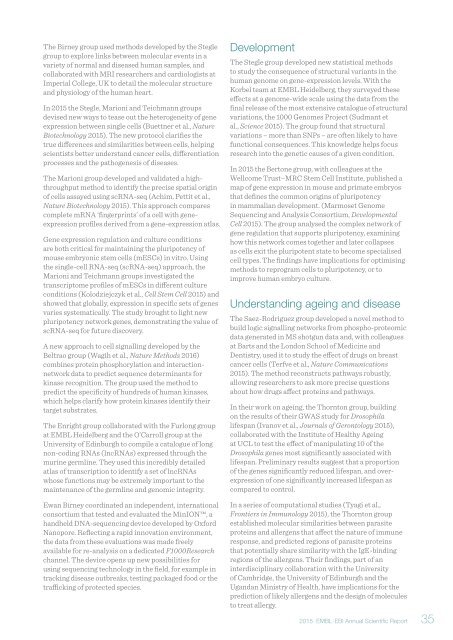Annual Scientific Report 2015
EMBL_EBI_ASR_2015_DigitalEdition
EMBL_EBI_ASR_2015_DigitalEdition
Create successful ePaper yourself
Turn your PDF publications into a flip-book with our unique Google optimized e-Paper software.
The Birney group used methods developed by the Stegle<br />
group to explore links between molecular events in a<br />
variety of normal and diseased human samples, and<br />
collaborated with MRI researchers and cardiologists at<br />
Imperial College, UK to detail the molecular structure<br />
and physiology of the human heart.<br />
In <strong>2015</strong> the Stegle, Marioni and Teichmann groups<br />
devised new ways to tease out the heterogeneity of gene<br />
expression between single cells (Buettner et al., Nature<br />
Biotechnology <strong>2015</strong>). The new protocol clarifies the<br />
true differences and similarities between cells, helping<br />
scientists better understand cancer cells, differentiation<br />
processes and the pathogenesis of diseases.<br />
The Marioni group developed and validated a highthroughput<br />
method to identify the precise spatial origin<br />
of cells assayed using scRNA-seq (Achim, Pettit et al.,<br />
Nature Biotechnology <strong>2015</strong>). This approach compares<br />
complete mRNA ‘fingerprints’ of a cell with geneexpression<br />
profiles derived from a gene-expression atlas.<br />
Gene expression regulation and culture conditions<br />
are both critical for maintaining the pluripotency of<br />
mouse embryonic stem cells (mESCs) in vitro. Using<br />
the single-cell RNA-seq (scRNA-seq) approach, the<br />
Marioni and Teichmann groups investigated the<br />
transcriptome profiles of mESCs in different culture<br />
conditions (Kolodziejczyk et al., Cell Stem Cell <strong>2015</strong>) and<br />
showed that globally, expression in specific sets of genes<br />
varies systematically. The study brought to light new<br />
pluripotency network genes, demonstrating the value of<br />
scRNA-seq for future discovery.<br />
A new approach to cell signalling developed by the<br />
Beltrao group (Wagih et al., Nature Methods 2016)<br />
combines protein phosphorylation and interactionnetwork<br />
data to predict sequence determinants for<br />
kinase recognition. The group used the method to<br />
predict the specificity of hundreds of human kinases,<br />
which helps clarify how protein kinases identify their<br />
target substrates.<br />
The Enright group collaborated with the Furlong group<br />
at EMBL Heidelberg and the O’Carroll group at the<br />
University of Edinburgh to compile a catalogue of long<br />
non-coding RNAs (lncRNAs) expressed through the<br />
murine germline. They used this incredibly detailed<br />
atlas of transcription to identify a set of lncRNAs<br />
whose functions may be extremely important to the<br />
maintenance of the germline and genomic integrity.<br />
Ewan Birney coordinated an independent, international<br />
consortium that tested and evaluated the MinION, a<br />
handheld DNA-sequencing device developed by Oxford<br />
Nanopore. Reflecting a rapid innovation environment,<br />
the data from these evaluations was made freely<br />
available for re-analysis on a dedicated F1000Research<br />
channel. The device opens up new possibilities for<br />
using sequencing technology in the field, for example in<br />
tracking disease outbreaks, testing packaged food or the<br />
trafficking of protected species.<br />
Development<br />
The Stegle group developed new statistical methods<br />
to study the consequence of structural variants in the<br />
human genome on gene-expression levels. With the<br />
Korbel team at EMBL Heidelberg, they surveyed these<br />
effects at a genome-wide scale using the data from the<br />
final release of the most extensive catalogue of structural<br />
variations, the 1000 Genomes Project (Sudmant et<br />
al., Science <strong>2015</strong>). The group found that structural<br />
variations – more than SNPs – are often likely to have<br />
functional consequences. This knowledge helps focus<br />
research into the genetic causes of a given condition.<br />
In <strong>2015</strong> the Bertone group, with colleagues at the<br />
Wellcome Trust–MRC Stem Cell Institute, published a<br />
map of gene expression in mouse and primate embryos<br />
that defines the common origins of pluripotency<br />
in mammalian development. (Marmoset Genome<br />
Sequencing and Analysis Consortium, Developmental<br />
Cell <strong>2015</strong>). The group analysed the complex network of<br />
gene regulation that supports pluripotency, examining<br />
how this network comes together and later collapses<br />
as cells exit the pluripotent state to become specialised<br />
cell types. The findings have implications for optimising<br />
methods to reprogram cells to pluripotency, or to<br />
improve human embryo culture.<br />
Understanding ageing and disease<br />
The Saez-Rodriguez group developed a novel method to<br />
build logic signalling networks from phospho-proteomic<br />
data generated in MS shotgun data and, with colleagues<br />
at Barts and the London School of Medicine and<br />
Dentistry, used it to study the effect of drugs on breast<br />
cancer cells (Terfve et al., Nature Communications<br />
<strong>2015</strong>). The method reconstructs pathways robustly,<br />
allowing researchers to ask more precise questions<br />
about how drugs affect proteins and pathways.<br />
In their work on ageing, the Thornton group, building<br />
on the results of their GWAS study for Drosophila<br />
lifespan (Ivanov et al., Journals of Gerontology <strong>2015</strong>),<br />
collaborated with the Institute of Healthy Ageing<br />
at UCL to test the effect of manipulating 10 of the<br />
Drosophila genes most significantly associated with<br />
lifespan. Preliminary results suggest that a proportion<br />
of the genes significantly reduced lifespan, and overexpression<br />
of one significantly increased lifespan as<br />
compared to control.<br />
In a series of computational studies (Tyagi et al.,<br />
Frontiers in Immunology <strong>2015</strong>), the Thornton group<br />
established molecular similarities between parasite<br />
proteins and allergens that affect the nature of immune<br />
response, and predicted regions of parasite proteins<br />
that potentially share similarity with the IgE-binding<br />
regions of the allergens. Their findings, part of an<br />
interdisciplinary collaboration with the University<br />
of Cambridge, the University of Edinburgh and the<br />
Ugandan Ministry of Health, have implications for the<br />
prediction of likely allergens and the design of molecules<br />
to treat allergy.<br />
<strong>2015</strong> EMBL-EBI <strong>Annual</strong> <strong>Scientific</strong> <strong>Report</strong> 35


